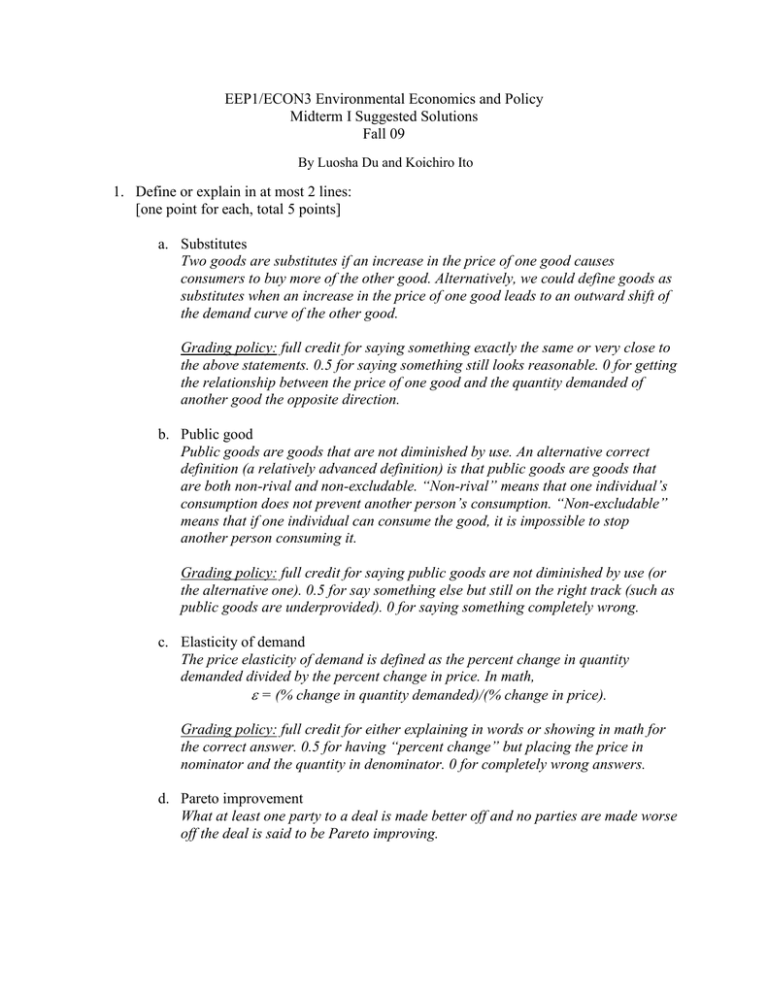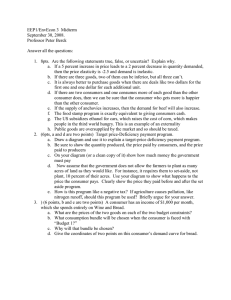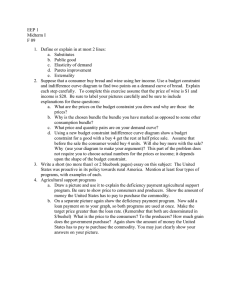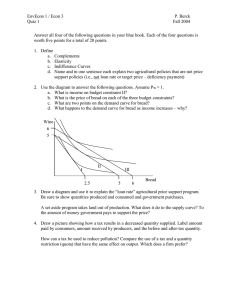EEP1/ECON3 Environmental Economics and Policy Midterm I Suggested Solutions Fall 09
advertisement

EEP1/ECON3 Environmental Economics and Policy Midterm I Suggested Solutions Fall 09 By Luosha Du and Koichiro Ito 1. Define or explain in at most 2 lines: [one point for each, total 5 points] a. Substitutes Two goods are substitutes if an increase in the price of one good causes consumers to buy more of the other good. Alternatively, we could define goods as substitutes when an increase in the price of one good leads to an outward shift of the demand curve of the other good. Grading policy: full credit for saying something exactly the same or very close to the above statements. 0.5 for saying something still looks reasonable. 0 for getting the relationship between the price of one good and the quantity demanded of another good the opposite direction. b. Public good Public goods are goods that are not diminished by use. An alternative correct definition (a relatively advanced definition) is that public goods are goods that are both non-rival and non-excludable. “Non-rival” means that one individual’s consumption does not prevent another person’s consumption. “Non-excludable” means that if one individual can consume the good, it is impossible to stop another person consuming it. Grading policy: full credit for saying public goods are not diminished by use (or the alternative one). 0.5 for say something else but still on the right track (such as public goods are underprovided). 0 for saying something completely wrong. c. Elasticity of demand The price elasticity of demand is defined as the percent change in quantity demanded divided by the percent change in price. In math, = (% change in quantity demanded)/(% change in price). Grading policy: full credit for either explaining in words or showing in math for the correct answer. 0.5 for having “percent change” but placing the price in nominator and the quantity in denominator. 0 for completely wrong answers. d. Pareto improvement What at least one party to a deal is made better off and no parties are made worse off the deal is said to be Pareto improving. Grading policy: full credit for saying “at least one party better off and no parties worse off”. 0.5 for saying both parties should better off or no parties are made worse off. 0 for getting completely wrong, such as both parties are worse off. e. Externality Externalities are costs or benefits arising from an economic activity that affect individuals other than those people directly engaged in the economic activity. Grading policy: full credit for saying externality is an effect borne by someone rather than the buyer and the seller. 0.5 for saying something else but still reasonable. 0 for saying the effect on individuals that are internal to the transaction. 2. Suppose that a consumer buy bread and wine using her income. Use a budget constraint and indifference curve diagram to find two points on a demand curve of bread. Explain each step carefully. To complete this exercise, assume that the price of wine is $1 and income is $20. Be sure to label your pictures carefully and be sure to include explanations for these questions: a. What are the prices on the budget constraint you drew and why are those the prices? Wine 20 BC1 BC2 5 10 Bread Figure 1 This is one possible graph you can come up with. Any price of bread is acceptable as long as it is consistent with your diagram. First, since the income is 20 and the price of wine is 1, you should have the intercept for wine at 20. Second, to figure out the prices of bread from the diagram, you need to use the intercepts for bread and the income, which tells you how much bread the consumer can buy if he/she spends all his/her income. On BC1, the price of bread is $20/5=$4 and on BC2, the price of bread becomes $20/10=$2. b. Why is the chosen bundle the bundle you have marked as opposed to some other consumption bundle? Wine 20 8 A B IC2 BC1 3 5 6 IC1 BC2 10 Bread Figure 2 Again, this is only one possibility that you could draw. With BC1, the consumer chooses bundle A (3 bread, 8 wine) because it gives her the highest utility under BC1. Alternatively, you could argue that point A is the tangency point between the budget constraint and an indifference curve. Similar explanations are applied to the bundle B (6 bread, 8 wine). This example happens to have 8 wine at A and B, but they do not have to be the same. Grading policy for a) and b): Part a) and b) have 3 points in total. One point for drawing a reasonable diagram corresponding to the question. One point for explaining why your price of bread is consistent with your diagram. One point for explaining why the marked bundle is the bundle chosen as opposed to some other consumption bundle. c. What price and quantity pairs are on your demand curve? Based on what has been discussed on part b), two pairs of price and quantity on the demand curve for bread are ( P1 4, Q1 3) and ( P2 2, Q2 6) . Grading policy: this part counts one point. Here, you don’t have to draw the demand curve although it may help your understanding. Your answer should be consistent with your diagram that you drew in part a) and b). d. Using a new budget constraint indifference curve diagram show a budget constraint for a good with a buy 4 get the rest at half price sale. Assume that before the sale the consumer would buy 4 units. Will she buy more with the sale? Why (use your diagram to make your argument)? This part of the problem does not require you to choose actual numbers for the prices or income; it depends upon the shape of the budget constraint. x2 A B BC with a sale 4 >4 x1 Figure 3 For this question, your price of two goods and income can be anything. However, you need the following two things. First, the budget constraint needs to be kinked at X1=4 with a sale. Second, since the question assumes that she would buy 4 units of good 1 if there were no sale, an indifference curve should be tangent on the original budget constraint at X1=4. Therefore, we are sure that she buys more than 4 units of good 1 if there is a sale because other indifference curve which gives her higher utility is tangent on the kinked budget constraint somewhere like B, which leads an increase in the consumption of good 1. Grading policy: this part counts one point. 0.5 for drawing a kinked budget constraint kinked at X1=4. 0.5 for saying she will buy more units of good 1if there is a sale and explaining why. 3. Write a short (1 or 2 bluebook pages) essay on this subject: The United States was proactive in its policy towards rural America. Mention at least four types of programs, with examples of each. In class, we covered the following four types of US farm programs: 1. Give Away [Examples: Railroad land grants, Homestead Act and etc.] 2. Raise Price [Examples: Deficiency payment/target price program, Loan program, and conservation reserve or set aside programs and etc.] 3. Build Infrastructure [Examples: Railroads, Dams, Electric lines, Reclamation act and etc.] 4. Create Financial Institutions [Examples: Federal farm loan act, Farm credit act, PCA, Land bank, Crop insurance and etc.] (A sample answer) The United States was proactive in its policy towards rural America. For instance, the government implemented the following four types of farm programs in the past. First, the government supported farmers by giving away land, trees, minerals, and grazing. Examples include the railroad land grants and the Homestead Act. Second, the government used marketing orders to raise prices of farm products so that farmers can receive higher prices than the market equilibrium price. Examples include deficiency payment/target price programs, loan programs, and conservation reserve or set aside programs. Third, building infrastructures such as railroads, dams, and electric lines also helped farmers to produce and sell their products effectively. Finally, the financial institutions created by the government also played a key role to support farmers. For example, the Farm Credit Act provided Production Credit Associations money to lend for short-term purposes. Grading policy: This question has 5 points. Mentioning each of four programs counts 0.5 each. Mentioning at least one example for each of four types of programs counts 0.5 each. 1 point is for making a reasonably well-explained essay on the subject. 4. Agricultural support programs a. Draw a picture and use it to explain the deficiency payment agricultural support program. Be sure to show price to consumers and producers. Show the amount of money the United States has to pay to purchase the commodity. p pT=ps Govt payment pdT Qs=Qd Q Figure 4 Price to producers is just the target price pT and pdT indicates the price consumer pays and the shaded box is the deficiency payment by the government. Grading policy: this part counts 3 points. The correct producer price, consumer price, and government payment count one point each. You don’t have to explain in words. Labeling the answers on the graph is sufficient. b. On a separate picture again show the deficiency payment program. Now add a loan payment on to your graph, so both programs are used at once. Make the target price greater than the loan rate. (Remember that both are denominated in $/bushel) What is the price to the consumers? To the producers? How much grain does the government purchase? Again show the amount of money the United States has to pay to purchase the commodity. You may just clearly show your answers on your picture. p quantity purchased by govt PT=Ps PL=Pd Govt payment Qs Qd Q Figure 5 Since the target price is greater than the loan rate, the producer price does not change from pT. However, the consumer’s price is now equal to the loan rate. The government purchases the difference between the quantity supplied and the quantity demanded. In addition, the government pays the difference between Ps and Pd for Qd. The gray shaded area is the total government payment, which consists of two parts: 1) the quantity gap times the target price; 2) and the price gap between target price and loan rate times the quantity demanded. Grading policy: this part counts two points. The correct producer price, consumer price, quantity purchased by the government and total government payment counts 0.5 points. You don’t have to explain in words. Labeling the answers on the graph is sufficient.


